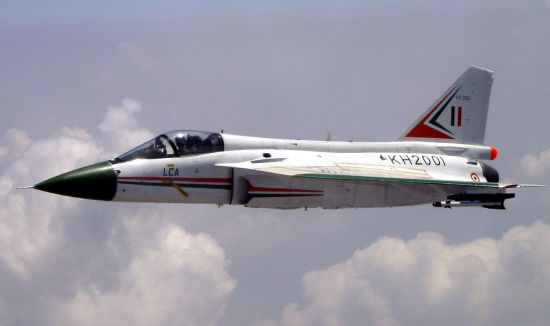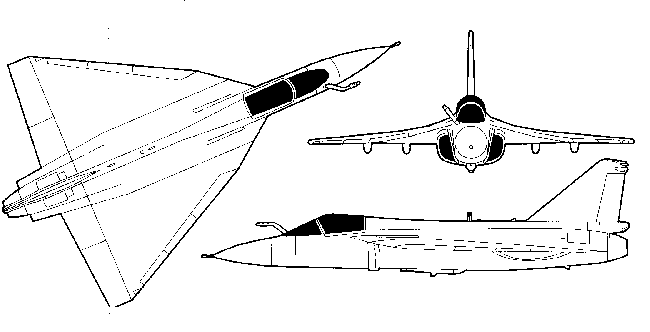|
||||||||||
|
|
||||||||||
|
||||||||||
|
|
||||||||||
 - -
|
|

|
Hindustan (HAL) Tejas / Light Combat Aircraft (LCA) Light Multi-Role Fighter |
|
DESCRIPTION:
India began pursuing the Light Combat Aircraft (LCA) project in 1983. Officially named Tejas (Sanskrit for radiance) in 2003, the LCA was developed as a lightweight, low-cost replacement for India's aging fleet of MiG-21 fighters. Under the overall direction of India's Aeronautical Development Agency (ADA), the prime contractor Hindustan was given responsibility for most LCA design and fabrication work. HAL is also responsible for integrating the efforts of several government laboratories, educational institutes, and sub-contractors. The Tejas uses a delta wing design featuring many advanced modern technologies, including a digital fly-by-wire control system, integrated avionics, extensive use of composite materials, and glass cockpit displays. Other sophisticated features include the aircraft's multi-mode radar, laser designator pod and FLIR system, ring laser gyro inertial navigation system, comprehensive electronic warfare suite, and jam-resistant communications sytems. Unfortunately, the Tejas program has encountered several delays that have extended the development effort by perhaps two decades. The LCA first ran into trouble as the design was being finalized in 1990 when a government commission found several deficiencies in critical technology areas. These findings resulted in the decision to build two technolgy demonstrator aircraft to ensure these issues could be resolved. The first of these aircraft rolled out in 1995, but difficulties with the flight control system and manufacturing of composite structural components kept the plane grounded. Another major setback occurred in 1998 when India's nuclear tests prompted the US to place sanctions on the sale of General Electric F404 turbofans. These sanctions also ended Lockheed Martin's assistance in development of the flight control system. Nevertheless, India decided to proceed by investing in a domestically developed jet engine to replace the F404 on production aircraft. This decision incurred additional penalties since many delays and cost overruns have been encountered while developing the new Kaveri engine. These problems grew so severe that the decision was made to buy additional F404 engines, after America lifted its sanctions, for use on the initial Tejas production aircraft. It is hoped the Kaveri will ultimately become available by 2010. The first technology demonstrator (TD-1) finally took to the air in 2001. Once joined by TD-2 and two prototype vehicles (PV-1 and PV-2), these aircraft were used to test and verify the advanced technologies planned for the Tejas fleet. A second phase of testing began in late 2006 with the first flight of the production prototype vehicle PV-3. Other test vehicles to be completed include prototypes of a naval variant (PV-4) and a trainer model (PV-5). Weapon integration flight testing began in 2007 and low-rate production was due to start by 2008. Despite signs of progress, ongoing engine problems and test delays have pushed service entry as late as 2015. The naval variant is being developed as a replacement for the Sea Harrier.
Last modified 07 October 2010
|
|
| HISTORY: | |
| First Flight | (TD-1) 4 January 2001 |
|
Service Entry
|
planned for 2015
|
| CREW: |
one: pilot
|
|
ESTIMATED COST:
|
$21 million
|
| AIRFOIL SECTIONS: | |
| Wing Root | unknown |
|
Wing Tip
|
unknown
|
| DIMENSIONS: | |
| Length | 43.27 ft (13.20 m) |
| Wingspan | 26.88 ft (8.20 m) |
| Height | 14.42 ft (4.40 m) |
| Wing Area | 412.6 ft² (38.4 m²) |
|
Canard Area
|
not applicable
|
| WEIGHTS: | |
| Empty | 12,125 lb (5,500 kg) |
| Normal Takeoff | 18,740 lb (8,500 kg) [clean] |
| Max Takeoff | 27,560 lb (12,500 kg) |
| Fuel Capacity |
internal: 795 gal (3,000 L) external: 1,055 gal (4,000 L) |
|
Max Payload
|
8,820 lb (4,000 kg)
|
| PROPULSION: | |
| Powerplant |
(prototypes) one General Electric F404-F2J3 or F404-IN20 turbofan (production) one GTRE GTX-35VS Kaveri turbofan |
| Thrust |
(F404-F2J3) 18,100 lb (80.50 kN) (F404-IN20) 18,700 lb (83.18 kN) (GTX) 20,200 lb (89.86 kN) |
| PERFORMANCE: | |
| Max Level Speed |
at altitude: 1,195 mph (1,920 km/h) at 36,000 ft (11,000 m), Mach 1.8 at sea level: unknown |
| Initial Climb Rate | unknown |
| Service Ceiling | 50,000 ft (15,250 m) |
| Range | 460 nm (850 km) |
| g-Limits |
+9 / -3.5
|
| ARMAMENT: | |
| Gun | one 23-mm GSh-23 twin-barrel cannon (220 rds) |
| Stations | eight external hardpoints |
| Air-to-Air Missile | R-77/AA-12 Adder, R-73/AA-11 Archer, BVRAAM |
| Air-to-Surface Missile | up to two conventional cruise missiles, anti-ship missiles |
| Bomb | laser-guided bombs, conventional bombs, cluster bombs |
| Other |
rocket pods
|
| KNOWN VARIANTS: | |
| LCA-TD-1 | First technology demonstrator equipped with a General Electric F404-F2J3 turbofan |
| LCA-TD-2 | Second technology demonstrator |
| LCA-PV-1 and PV-2 | Single-seat prototype vehicles |
| LCA-PV-3 | Single-seat prototype vehicle that should be at or very close to production form, equipped with in-flight refueling capability |
| LCA-PV-4 | Single-seat prototype vehicle for a naval variant |
| LCA-PV-5 | Two-seat trainer prototype vehicle |
| Tejas | Production model for the Indian Air Force |
| Trainer | Two-seat trainer model |
| Navy model | A navalized version with strengthened landing gear and a redesigned forward fuselage to be used aboard a future Indian aircraft carrier |
| MCA |
Planned Medium Combat Aircraft derived from the LCA, supposed to possess greater stealth characteristics
and thrust-vectoring capability
|
|
KNOWN COMBAT RECORD:
|
not yet in service
|
|
KNOWN OPERATORS:
|
India, Bharatiya Vayu Sena (Indian Air Force) India (Indian Naval Air Squadron) |
|
3-VIEW SCHEMATIC:

|
|
SOURCES:
|
|


|
Aircraft | Design | Ask Us | Shop | Search |

|
|
| About Us | Contact Us | Copyright © 1997-2023 | |||
|
|
|||